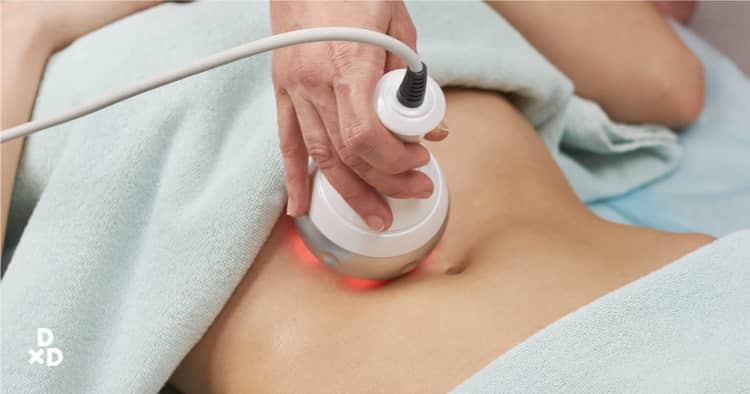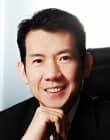As we get older, our skin loses its elasticity. Exposure with UV rays speeds up the ageing process. In order to have healthy and nourished looking skin, supplementary treatments have become a necessity. There is now a wide variety of treatments available for you to try. These range from creams and non-invasive facial treatments, to highly invasive surgical procedures.
In the course of my career as an aesthetic doctor for over 10 years, I have done countless anti-ageing treatments in Singapore.
Therefore, I will explain all you need to know about ageing skin- from the symptoms, skin treatments that delay the ageing process, the do’s and don'ts, as well as the cost of the treatments and procedures that you might be interested in trying.
Why does skin age?
Skin ageing is caused by processes in your body (intrinsic skin ageing) and environmental factors (extrinsic factors). [1]
Intrinsic skin ageing is the natural ageing process that takes place over the years regardless of outside influences. After the age of 20, a person produces about 1% less collagen in the skin each year, and cellular turnover decreases by 28%.
There is also reduced elastin production, less glycosaminoglycans (GAGs) formation and diminished functioning of oil glands.
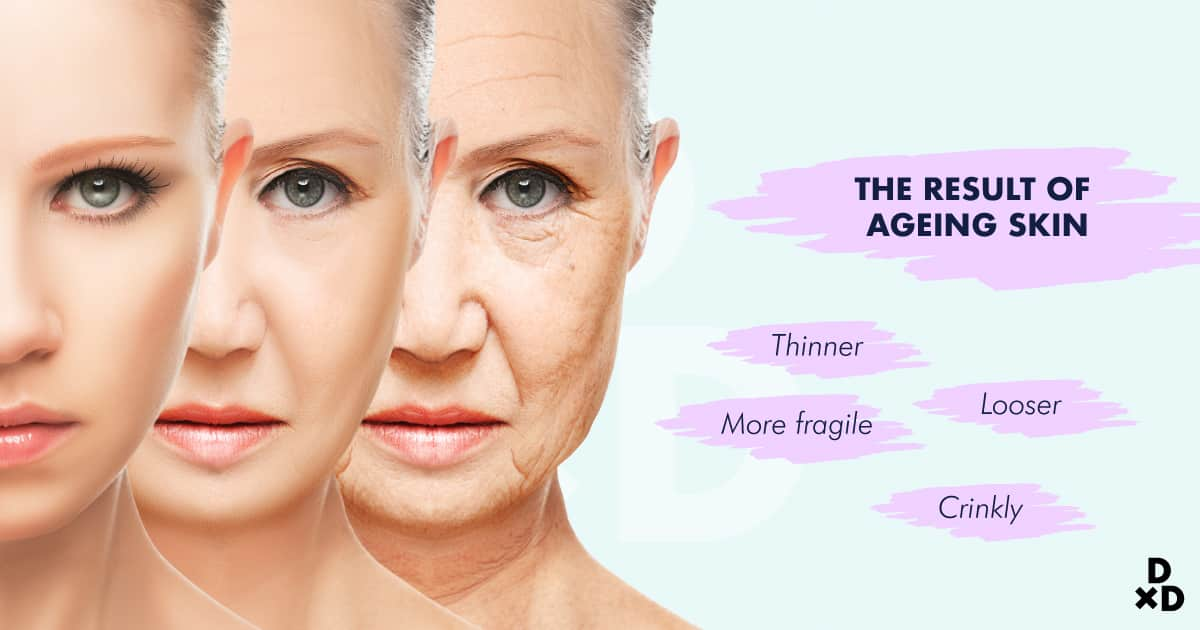
As a result, ageing skin becomes:
- Thinner
- Looser
- More fragile
- Crinkly
Moreover, as the body’s repair and regenerative abilities become compromised with cumulative damage, signs of skin ageing appear. [2]
Extrinsic skin ageing adds to the intrinsic ageing as a result of external factors such as sun and environmental damage (e.g. smoking, exposure to pollution). Extrinsic ageing shows up as:
- Thickening of the cornified (dead skin) layer.
- Precancerous changes and skin cancer
- Sunspot formation
- Exaggerated and premature loss of collagen, elastin, and GAGs.
Alone or in unison, these processes give the skin the appearance of
- Roughness
- Dullness
- Uneven tone
- Brown patches
- Thin skin
- Deep wrinkles.
An important fact that most of my patients do not realise is that facial ageing is more than skin deep. As our bodies age, some of the fat pads and facial bones that provide support under the skin naturally shrink as well.
Other fat pads, such as those in the cheeks and “jowl” areas, descend with gravity over time as supportive ligaments weaken. As a result, sagging occurs, folds around the mouth deepen and we often notice unflattering hollows around the eyes, temples and lower cheeks.
Muscular habits and imbalances further complicate things. Strong repetitive skin creasing by expression muscles etches increasingly prominent lines and wrinkles in the face, especially with deteriorating skin elasticity or depletion of fat.
Blunting of an ageing jawline is commonly worsened by the downward pull of relatively overactive neck muscles trying to find resting tone on the resorbing jaw bone. In the upper face, the forehead muscles often become over-engaged subconsciously to keep saggy brows and droopy eyelids from closing onto the eyes.
This commonly presents as deep horizontal forehead lines (instead of saggy brows) and can be tricky to treat, since conventional treatment with Botox by less experienced doctors will take away the compensatory forehead muscle contraction to fully reveal the droopy eyes.
What are the signs of ageing?
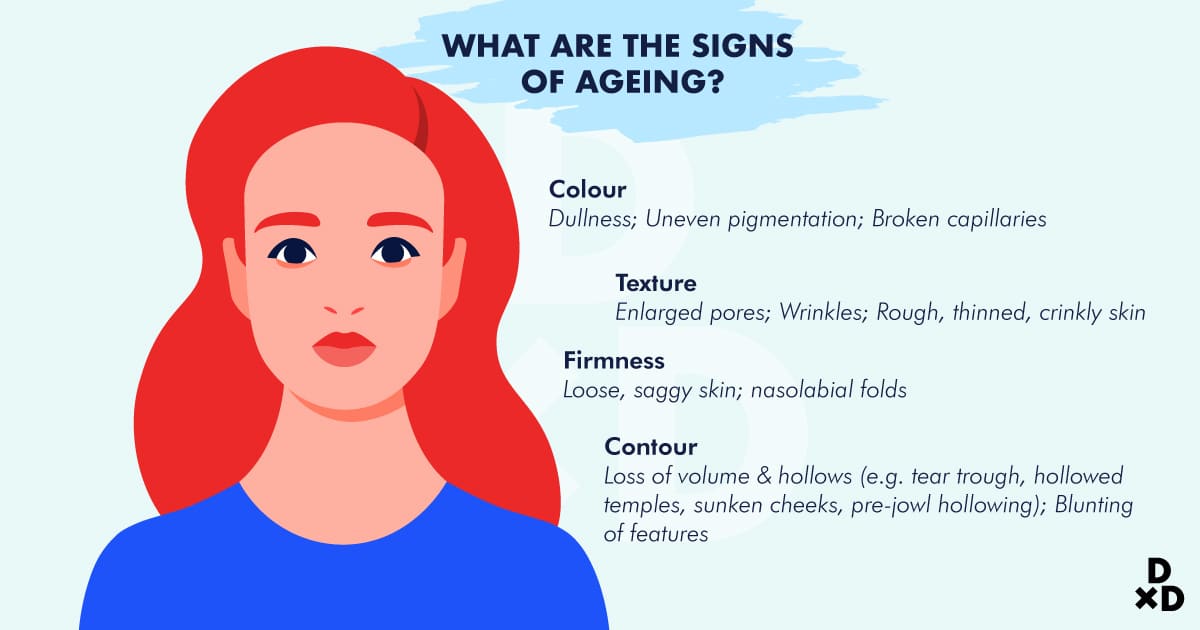
Everyone, including a young child, can immediately recognise an older, haggard-looking face from a youthful, fresher looking one. However, it is important to realise that different faces age in different ways. Hence, different treatment strategies are required to be effective.
What I find useful as a quick “working formula” to help me systematically assess and guide treatment planning is to consider the five key dimensions of radiant, youthful skin: [3]
Colour - Dullness; Uneven pigmentation; Broken capillaries
Texture - Enlarged pores; Wrinkles; Rough, thinned, crinkly skin
Firmness - Loose, saggy skin; nasolabial folds
Contour - Loss of volume & hollows (e.g. tear trough, hollowed temples, sunken cheeks, pre-jowl hollowing); Blunting of features
Hydration
When this “equation” is balanced and optimised, the skin is in its beautiful best. If one or two dimensions are more severely affected than the rest, I will set the treatment priorities accordingly.
Why do some people have signs of ageing earlier than others?
Some people just look older or younger than they are. Genetics, facial structure and hormonal status all play important roles in determining how we age.
In addition, our skin takes quite a beating on a daily basis from a myriad of environmental (e.g. sun, pollution, high energy blue light from our gadgets) and lifestyle (e.g. smoking, sleep deprivation, stress, excess sugar and alcohol intake, intense squinting and creasing of skin, rapid weight loss, etc.) aggressors. After all, genetics loads the gun, and our environment pulls the trigger.
These external factors significantly accelerate skin ageing, but are often modifiable. Unfortunately, while most of us know about these modifiable factors, not many are taking the necessary steps early and consistently enough to protect their skin against them.
What anti ageing treatments are available and how much do they cost in Singapore?
We are very fortunate to have a wide and growing variety of non-surgical skin rejuvenation treatments to address different aspects of skin ageing. This overwhelming selection can be confusing for most people, but I have tried to summarise it with a more concise list of the most commonly used types of treatment that are scientifically-backed:
- Lasers and Nitrogen Plasma
- Radiofrequency skin tightening
- Ultherapy (and other HIFU devices)
- Threadlift
- BOTOX (and other botulinum toxins)
- Fillers (hyaluronic acid and collagen-stimulating fillers)
- SkinBoosters (e.g. hyaluronic acid, Rejuran Healer)
- Chemical Peels, Microdermabrasion and Hydradermabrasion
Duration:
Cost per session:
How many sessions are recommended:
Downtime:
Targeted area:
Lasers and Nitrogen Plasma Skin Rejuvenation
15-60 min
Depends on laser(s) used
Variable, but often a course of 3-6 sessions for many lasers
Zero to minimal for most lunchtime lasers and nitrogen plasma skin rejuvenation.
3-7 days for resurfacing lasers.
Various skin complexion issues (eg. hyperpigmentation, broken capillaries, dullness, lines, crepey thinned skin, skin laxity)
Radiofrequency (RF) Skin Tightening
30-60 min
From $400
1-4 sessions
Nil
Lines, Skin laxity
Ultherapy (and HIFU)
1-2 hrs
From $2,000
1 per year
Nil
Face/Brows/Neck firming and non-invasive lifting
Thread Lift
1 hr
From $1,500
1 per year
2 days
Face/Undereyes/ Neck firming, lifting
BOTOX
15min
From $225
2-3 per year
Minimal
Expression wrinkles; Facial Slimming; Brow lifting; Jawline definition
Fillers
30-45min
From $850
1-2 per year
Minimal
Lift hollows and folds. Support saggy skin. Define blunted features.
SkinBoosters
30-45min
From $400
Depending on type of skinbooster. 1-3 sessions
1-2 days
Improve skin hydration, radiance, texture and elasticity
Chemical Peels, Microdermabrasion, Hydradermabrasion
30-60min
From $180
Monthly
Nil
Improve skin clarity and smoothness
Also read: Is Microneedling for You?: The Complete Guide (2021)
What are the benefits of going for anti-ageing treatments?
Skin rejuvenation treatments are part of the holistic 360-degree look at graceful ageing that is rapidly gaining popularity.
With anti-ageing treatments, we aim to improve skin health, repair damage and restore part of what time has taken away. This aids in maintaining a naturally youthful appearance. Many of my patients can testify that when a person looks good, they feel good inside out.
The availability of new non-surgical technological "tweakments" that require no downtime also means patients can simply zip in for a treatment and walk out, looking more refreshed with healthier, better skin.
What are the things that your patients look out for when seeking for anti-ageing treatments?
Living in a fast-paced sophisticated society, the majority of patients that I see look for non-invasive or minimally invasive treatments. With advanced technology, these treatments have well-proven safety and efficacy, providing natural-looking results and lesser downtime or pain.
How effective are mini anti-ageing treatments?
Treatment should be done in accordance with the recommendations based on data from clinical studies to be effective. For example, “mini” laser treatments done to reduce the upfront costs tend to give “mini” results or less.
In fact, over-frequent “mini” treatments may not allow sufficient skin healing time between sessions and can increase the risk of unwanted side effects.
Of course, it goes without saying that the level of experience and expertise of the person administering the treatment is of utmost importance.
Lastly, it is important to remember that results do take time to show. The body takes time to respond and regenerate itself after anti-ageing treatments before visible improvements can be seen.
How can I prolong the effects of anti-ageing treatment?
Anti-ageing treatments aim to restore healthy skin function, replenish collagen and other components found in youthful skin. Hence, the same anti-ageing skincare and lifestyle measures (e.g. a healthy diet and daily sunscreen) that protect against ongoing external damage, slow down collagen breakdown and support skin regeneration will help you enjoy the treatment benefits the fullest and longest.
That being said, changing one's habits is often more easily said than done, so it is wonderful to see many of my patients become more motivated to take better care of their bodies after treatment.
How often should I go for anti-ageing sessions?
Your doctor will advise you on the treatment schedule according to the type of treatment, your skin condition and skin response to achieve the best results.
For example, a course of six Neogen Plasma sessions is done regularly at monthly intervals to reactivate healthy skin renewal, progressively repair sun damage and regenerate dermal collagen for tighter, smoother, brighter and clearer skin.
A non-invasive facelift like Ultherapy, on the other hand, is typically done once a year to stimulate collagen production intensively in the deeper layers below the skin, hence helping the face stay firm.
How often should anti-ageing treatments be in my skincare routine?
Just like it is necessary to keep our bodies healthy with exercise, keeping our skin youthful is all about regular maintenance over the long-term. Therefore, adding a simple skincare routine like wearing sunscreen or moisturiser regularly is highly necessary.
Who is suitable for anti-ageing treatments? When should I consider going for treatment?
The best time to start considering professional treatment is when the first signs appear. The signs such as:
- Relaxed skin around the mouth or eyes
- Fine lines
- Enlarging pores
- Increasing dullness or formation of pigment spots.
Usually, people who are interested in these treatments are those who are around 30 years old and above. Even though these treatments are popular amidst the female, I see an increasing number of male patients who are interested in these treatments as well.
While anti-ageing treatments are generally recommended when skin ageing signs start to be apparent, you can do a head start by incorporating preventive measures in your regime (such as wearing sunscreen, antioxidants and moisturiser) when you’re still in your 20s to take charge of your ageing process.
At what age can I start with anti-ageing treatments?
This is a common concern. The good news is: It is never too late to start. The type of treatment and regime recommended might differ from someone in their early 30s, but even older folks who already have signs of skin ageing can benefit from positive lifestyle changes and anti-ageing treatments to look like a fresher, healthier version of themselves.
How safe is anti-ageing treatments in Singapore? What are its potential side effects?
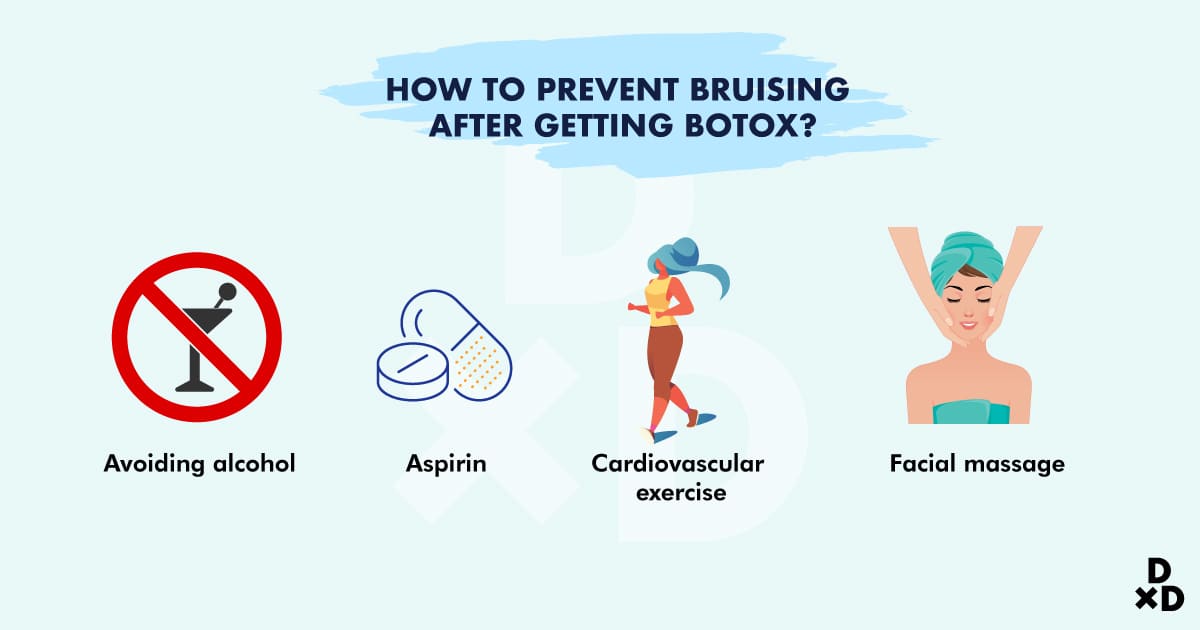
Many patients are amazed by how “easy” many treatments feel these days. But it is important to remember that there are some possible side effects with any treatment. These side effects are mostly minor, transient and easily managed.
For instance, if you are getting Botox microinjection, there is a small risk of minor bruising that can be easily concealed with makeup and will resolve in days. There are some simple measures that you can do to prevent bruising such as:
- Avoiding alcohol
- Aspirin-like (NSAIDS) painkillers and other blood-thinning oral supplements
- Cardiovascular exercise
- Facial massage
Ask your doctor about the details as expected skin recovery and potential side effects will vary between treatments. Mild transient skin flushing is anticipated after most lunchtime lasers and peels, however:
- Unexpected rashes
- Exaggerated swelling
- Hyper- or hypopigmentation
- Infection or scarring
Although the chances for them to appear is rare, they still can occur. Especially, if the treatment is not done properly or if post-procedure care is not followed.
Going to a skilled doctor experienced in performing the treatment, as well as complying to pre- and post-treatment skincare advice will minimise your risks.
Also read: Which anti-aging treatments are the most suitable for Rosacea-prone skin?
Why do doctors recommend a combination of anti-ageing treatments to tackle ageing?
Skin ageing affects different facets (firmness, texture, pigmentation, loss of volume) and affects multiple layers (skin, fat, muscles, bone) as well.
Unfortunately, there is no single treatment that can address everything adequately. Hence, a combination of non-invasive or minimally invasive little “tweakments” is often used to deliver natural and visible results, while minimising risks and downtime.
For instance, Ultherapy restores overall firmness in the deeper layers. NeoGen Plasma or laser skin rejuvenation then builds on that foundation to improve surface skin texture, fine lines and old scars, reveal a more even colour tone, and tighten the eyelids to give an “effortlessly refreshed” look.
How do I know which anti-ageing treatment is better or suitable for me?
You might need to consult your doctor in order to know which treatment is suitable for your skin, as well as for your personal expectations and lifestyle.
There is a wide range of treatments to consider based on your skin condition- be it skincare, non-invasive facial treatments, injectables, or more invasive procedures such as a surgical facelift.
Explore Facelift Options in Singapore with our guide.
How can I prepare for an anti-ageing procedure? What should I do to optimise results?
Preparation varies for different treatments, so your doctor is the best person to advise you on the details. Here are some general tips for common anti-ageing treatments:
Avoid sun tanning or direct sun exposure (e.g. going on a beach holiday) before and right after skin treatments like lasers.
Daily use of sunscreen and additional forms of sun protection before and after treatment is highly recommended.
Keep your skin well-moisturised before and after skin treatments to ensure a rapid and smooth recovery.
Check if there are any other special pre- and post-procedural skin regime is advised (e.g. avoiding facial scrubs, fruit acids and vitamin A creams).
Use specialised skin care to promote skin healing.
Avoid taking NSAIDS painkillers and blood-thinning oral supplements (e.g. gingko biloba, vitamin E, etc) before and right after injectable treatments like fillers and botox.
Inform your doctor if you have any chronic medical conditions.
If you are on any blood-thinning medications (e.g. aspirin) or other chronic medications.
If you are on oral Roaccutane
If you might be pregnant or are breast-feeding
If you have any previous facial surgery or other treatments done.
What happens during the examination?
The first consultation is to understand your concerns and preferences. It is during this initial assessment that I assess your skin condition to propose a suitable treatment plan.
Depending on the treatment that has been proposed, you can choose to begin the treatment on the same day or on a separate day after consultation.
What are some tips to slow down the signs of ageing?
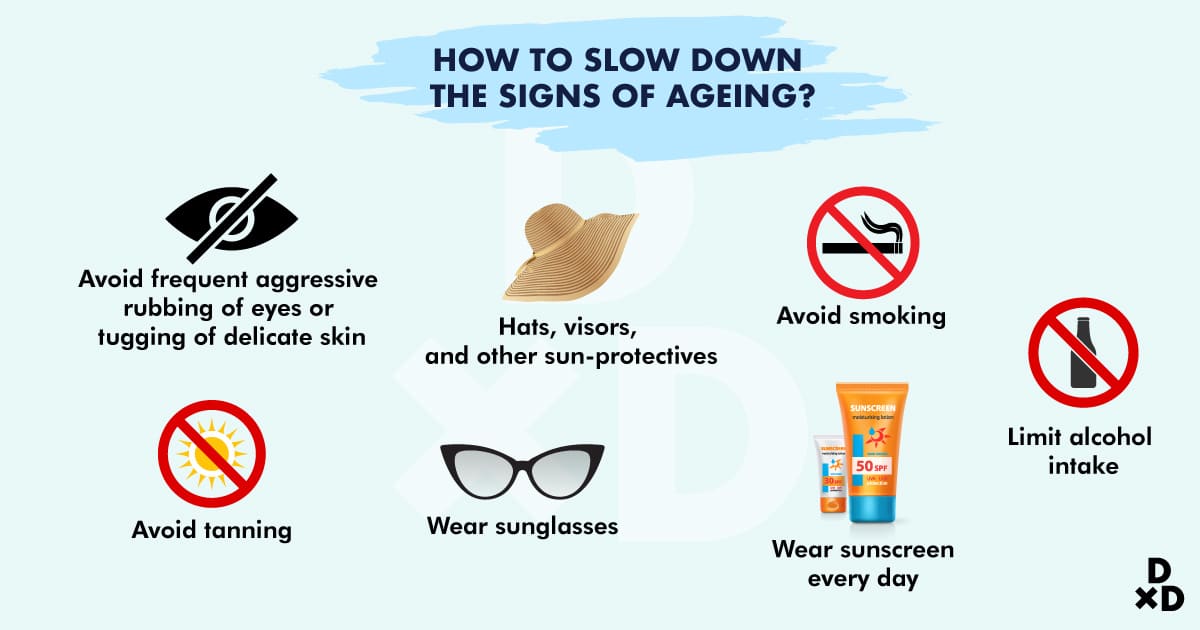
Simple measures done regularly in the long term can be effective to stave off signs of skin ageing. You can start by [4]
- Wear sunscreen every day. It is important to use a suitable broad-spectrum sunscreen (with SPF 30 and above) every day to protect your skin from the UVA and UVB rays. Some sun care products have added HEV filters and antioxidants to help reduce damage by visible blue light and pollution as well.
- Hats, visors, and other sun-protectives can provide additional sun protection.
- Avoid tanning because the ultraviolet radiation will damage your skin by causing discolouration, and damages the collagen and elastin.
- Wear sunglasses to minimise wrinkles from squinting and protect the eyes.
- Avoid frequent aggressive rubbing of eyes or tugging of delicate skin.
- Avoid smoking. Smoking can speed up the breakdown of collagen and impairs collagen regeneration and skin repair.
- Limit alcohol intake, and keep to a healthy diet and exercise regime.
In summary,
There are many things you can do and a whole variety of treatments to help you take charge of your skin ageing successfully. If the number of options overwhelm you, you are not alone.
I hope that this guide has helped you make a decision on how to better achieve youthful skin. What is most exciting about ageing in the age of modern technology is the ability to tackle each layer of the skin and remodel it for the best results with the least side effects.
We age in many different ways, and addressing all the issues in moderation allows for graceful ageing. It is no longer about freezing every wrinkle. Now, we investigate the wrinkles.









